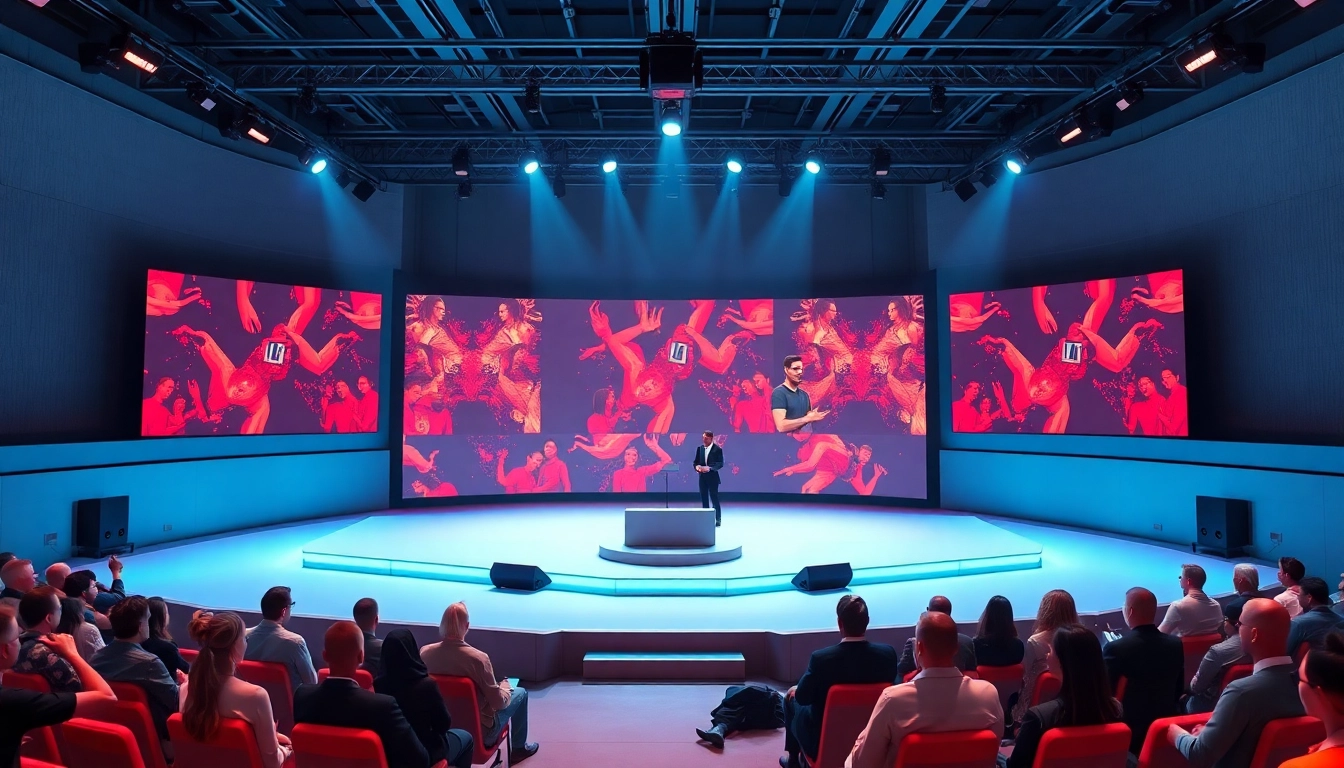Understanding Virtual Audience Systems
What is a Virtual Audience System?
A Virtual Audience System (VAS) is an innovative framework designed to enhance audience engagement during live events through digital platforms. By leveraging technology, a VAS allows event organizers to interact with participants remotely, integrating tools such as live polls, Q&A sessions, and interactive feedback mechanisms. This system creates a dynamic environment where attendees can participate actively, regardless of their physical location. The role of a VAS has become increasingly vital, especially in the wake of the digital transformation accelerated by global events such as the pandemic.
The central premise of a Virtual Audience System is to bridge the gap between the live audience present at an event venue and a virtual audience participating online. Utilizing this dual engagement approach not only broadens reach but also ensures that everyone’s voice is heard. By employing a comprehensive Virtual Audience System, event organizers can maximize the impact and effectiveness of their events.
Key Components of Virtual Audience Systems
Understanding the critical components of a Virtual Audience System is essential for effective implementation. The following are the key elements:
- Digital Platforms: These include software applications and tools that facilitate live streaming, audience interaction, and event management. Tools like Zoom, Microsoft Teams, and dedicated event platforms enable seamless connectivity.
- Engagement Tools: Features such as live polls, chat functions, and multimedia sharing enable participants to interact in real-time. These tools are crucial for maintaining audience interest and fostering interaction.
- Analytics and Feedback Mechanisms: Post-event analytics allows organizers to evaluate engagement levels and gather feedback. Metrics such as participation rates, user interaction data, and satisfaction surveys provide insights that drive future enhancements.
- Content Delivery: Quality content is at the heart of any Virtual Audience System. This includes not only presentations and speeches but also supplementary materials like videos, PDFs, and interactive elements that inspire participation.
Benefits of Implementing a Virtual Audience System
Integrating a Virtual Audience System within your events offers numerous advantages:
- Increased Reach: Virtual platforms allow organizations to connect with a global audience, significantly broadening the potential reach of any event.
- Cost Efficiency: Hosting virtual or hybrid events often incurs lower costs compared to traditional in-person gatherings. Expenses related to venue rental, catering, and on-site logistics can be minimized or eliminated.
- Enhanced Data Collection: VAS enables real-time data collection, allowing organizers to track engagement and gather valuable insights for future improvement.
- Improved Accessibility: Virtual Audience Systems cater to individuals who may face barriers in attending physical events, whether due to location, mobility issues, or other constraints.
How Virtual Audience Systems Transform Live Events
Engagement Strategies Using Virtual Audience Systems
To fully leverage the capabilities of a Virtual Audience System, event planners must employ effective engagement strategies. Here are some techniques to ensure meaningful interaction:
- Interactive Q&A Sessions: Allocate specific times for audience questions, encouraging participants to engage directly with speakers. This not only fosters a sense of inclusion but also enriches the discussion.
- Live Polls and Surveys: Use polls to gauge audience opinion during sessions, allowing for real-time audience feedback and making participants feel involved in the event.
- Breakout Sessions: In hybrid events, create small group discussions that foster conversation and collaboration, enhancing attendee connection and networking opportunities.
- Gamification: Implement game-like elements to incentivize participation and create a fun atmosphere. This could include contests, leaderboards, or interactive challenges.
Real-World Examples of Successful Implementations
To see the impact of Virtual Audience Systems in action, let’s explore a few exemplary cases:
- IBM Think 2021: This virtual conference attracted over 20,000 attendees worldwide. Through a robust VAS, IBM incorporated live polls and breakout sessions, significantly enhancing audience engagement.
- Salesforce Dreamforce: Transitioning to a hybrid format allowed Salesforce to engage both in-person and virtual attendees through interactive keynotes, live chats, and extensive networking opportunities via their VAS.
- TEDx Events: Many local TEDx events have successfully implemented a VAS to enable global participation. By utilizing live streams and digital platforms, they have significantly broadened their reach and audience diversity.
Comparing Traditional vs. Virtual Audience Systems
When comparing traditional audience engagement approaches to Virtual Audience Systems, several key differences emerge:
- Engagement: Traditional events often rely on passive participation, whereas VAS encourages active involvement through interactive tools.
- Accessibility: Virtual systems provide access to individuals unable to attend in person, expanding the audience base.
- Feedback Mechanisms: Traditional events may gather feedback post-event, while VAS allows for real-time adjustments based on audience interaction.
The evolution from traditional to virtual systems is not merely a trend; it represents a fundamental shift in how audiences engage with events, promoting greater connectivity and inclusivity.
Best Practices for Maximizing Virtual Audience Participation
Technical Setup for Effective Interaction
A robust technical setup is critical for the seamless operation of a Virtual Audience System. Consider the following best practices:
- Reliable Internet Connection: Ensure a stable, high-speed internet connection to facilitate smooth streaming and interactions.
- Equipment Quality: Invest in high-quality microphones, cameras, and lighting to enhance the audiovisual experience for both in-person and virtual attendees.
- Technical Rehearsals: Conduct dry runs to identify and resolve potential issues before the event. This includes testing software functionality and ensuring smooth transitions between different segments.
- Accessibility Features: Ensure your platform provides accessibility options, such as closed captioning or audio descriptions, to cater to diverse audience needs.
Creating Engaging Content for Virtual Audiences
The content shared during virtual events is paramount in retaining audience attention. Below are strategies for crafting engaging material:
- Visual Aids: Use compelling visuals to complement your message. This can include infographics, diagrams, and videos to enhance understanding.
- Storytelling: Utilize storytelling techniques to make your content relatable. Narratives that resonate emotionally can strengthen audience connection.
- Variety in Formats: Incorporate diverse content formats, such as panel discussions, interviews, and workshops, to cater to different learning preferences.
- Regular Breaks: Plan short breaks during lengthy sessions to help maintain attention and provide opportunities for informal networking.
Overcoming Common Challenges in Virtual Engagement
While engaging virtual audiences offers many benefits, it also presents unique challenges. Here’s how to overcome some common issues:
- Lack of Interaction: Combat this by incorporating interactive elements like polls, quizzes, and multi-channel discussions within the platform.
- Technical Issues: Have a dedicated technical support team on standby during the event to quickly address any issues that arise for both speakers and attendees.
- Audience Fatigue: To mitigate virtual fatigue, keep sessions concise and engaging, and encourage movement between segments.
- Participant Anonymity: Encourage participants to join with their cameras on or create small groups where they can share their thoughts more openly. This builds community and enhances engagement.
Measuring Success with Virtual Audience Systems
Key Metrics to Track Audience Engagement
To gauge the effectiveness of a Virtual Audience System, it is essential to track various engagement metrics. The following indicators can provide valuable insights:
- Participation Rates: Monitor the number of attendees versus registered participants to understand reach and interest levels.
- Engagement Levels: Track how many participants engage with interactive elements like polls, Q&As, or chats.
- Feedback Scores: Utilize post-event surveys to measure satisfaction and gather constructive criticism.
- Session Drop-off Rates: Analyze at which points participants are leaving the event to identify areas for improvement.
Tools and Analytics for Performance Evaluation
Utilizing the right tools is crucial for evaluating the performance of your Virtual Audience System. Here are some recommended analytics tools and software:
- Google Analytics: Essential for tracking web traffic, user behavior, and engagement metrics on event pages.
- Event Management Software: Platforms like Whova or Eventbrite offer built-in analytics to understand participant engagement and event success.
- Social Media Analytics: Use tools such as Hootsuite or Buffer to measure social media engagement during and after your events.
- Survey Tools: Platforms like SurveyMonkey can help in gathering feedback efficiently and allowing for real-time polling during events.
Adjusting Strategies Based on Audience Feedback
Regularly analyzing audience feedback is essential for refining event strategies. Here’s how to act on feedback effectively:
- Segment Feedback: Categorize feedback into actionable items, such as content quality, technical performance, and overall satisfaction.
- Follow-up Actions: Communicate to your audience the changes that will be implemented based on their feedback. This demonstrates that their opinions are valued and encourages future participation.
- Iterative Improvements: Adopt a continuous improvement approach. Utilize feedback to enhance content delivery, technical setup, and overall logistics in subsequent events.
Future Trends in Virtual Audience Systems
Emerging Technologies Shaping Virtual Engagement
The landscape of Virtual Audience Systems is constantly evolving. Here are some emerging technologies to watch:
- Artificial Intelligence: AI can optimize audience targeting and personalize interactions, creating a more tailored experience for participants.
- Augmented Reality (AR) and Virtual Reality (VR): Incorporating AR and VR into events could revolutionize the way audiences interact, offering immersive experiences that mimic physical presence.
- Blockchain: This technology may enhance transparency and security for virtual events, particularly in ticketing and transactions.
- 5G Technology: Increased bandwidth and speed will facilitate smoother streaming experiences and enable more complex interactions in real-time.
Evolving User Expectations and Preferences
As technology advances, so do user expectations regarding virtual events. Here are some trends to consider:
- Demand for Personalized Experiences: Attendees increasingly expect tailored content and interactions that cater to their preferences.
- Hybrid Event Preferences: Many participants appreciate the option to attend either in-person or online, highlighting the need for adaptable event formats.
- Increased Interaction: Users are seeking more interactive and engaging sessions that go beyond passive viewing, emphasizing the need for innovative engagement strategies.
Preparing for the Future of Virtual Events
To stay ahead in the evolving landscape of virtual events, organizers must be proactive:
- Stay Informed: Keep up with the latest trends and technologies shaping the virtual event space, ensuring you continually enhance your offerings.
- Invest in Professional Development: Training teams in emerging technologies can elevate the quality of your virtual and hybrid events.
- Engage with the Community: Participate in industry forums and discussions to learn from peers and share insights.
- Experiment and Innovate: Encourage a culture of experimentation where new ideas for engagement and content delivery are welcomed and tested.



